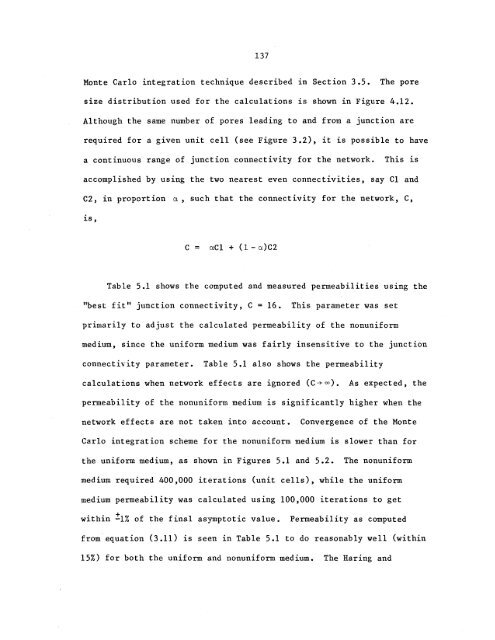longitudinal dispersion in nonuniform isotropic porous media
longitudinal dispersion in nonuniform isotropic porous media
longitudinal dispersion in nonuniform isotropic porous media
Create successful ePaper yourself
Turn your PDF publications into a flip-book with our unique Google optimized e-Paper software.
137<br />
Monte Carlo <strong>in</strong>tegration technique described 1n Section 3.5. The pore<br />
size distribution used for the calculations is shown <strong>in</strong> Figure 4.12.<br />
Although the same number of pores lead<strong>in</strong>g to and from a junction are<br />
required for a given unit cell (see Figure 3.2), it is possible to have<br />
a cont<strong>in</strong>uous range of junction connectivity for the network. This 1S<br />
accomplished by us<strong>in</strong>g the two nearest even connectivities, say C1 and<br />
C2, <strong>in</strong> proportion a, such that the connectivity for the network, C,<br />
is,<br />
C aC1 + (1-a)C2<br />
Table 5.1 shows the computed and measured permeabi1ities us<strong>in</strong>g the<br />
"best fit" junction connectivity, C = 16. This parameter was set<br />
primarily to adjust the calculated permeability of the <strong>nonuniform</strong><br />
medium, s<strong>in</strong>ce the uniform medium was fairly <strong>in</strong>sensitive to the junction<br />
connectivity parameter. Table 5.1 also shows the permeability<br />
calculations when network effects are ignored (C -+ (0). As expected, the<br />
permeability of the <strong>nonuniform</strong> medium is significantly higher when the<br />
network effects are not taken <strong>in</strong>to account. Convergence of the Monte<br />
Carlo <strong>in</strong>tegration scheme for the <strong>nonuniform</strong> medium is slower than for<br />
the uniform medium, as shown <strong>in</strong> Figures 5.1 and 5.2. The <strong>nonuniform</strong><br />
medium required 400,000 iterations (unit cells) , while the uniform<br />
medium permeability was calculated us<strong>in</strong>g 100,000 iterations to get<br />
with<strong>in</strong> 2:1% of the f<strong>in</strong>al asymptotic value. Permeability as computed<br />
from equation (3.11) 1S seen <strong>in</strong> Table 5.1 to do reasonably well (with<strong>in</strong><br />
15%) for both the uniform and <strong>nonuniform</strong> medium. The Har<strong>in</strong>g and

















